50 Iconic Prints that Rocked the World
We love print. You can touch it, hold it, even smell it. It can be so powerful it stops you in your tracks. Print is timeless. It remembers where we came from and looks forward to future events. It’s there even when we unplug.
These posters are the essence of iconic print. They celebrate the leaders we follow, the causes we support and the artists we admire. They’re held high at political rallies and stuck to the back of bedroom doors. The best posters don’t just illustrate history — they shape it. These are our kind of posters.
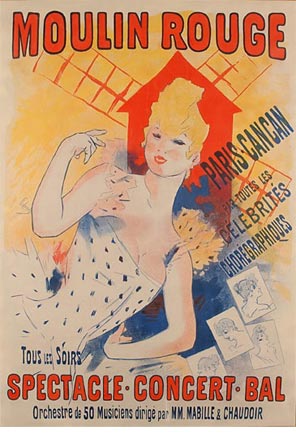
Moulin Rouge
The poster as we know it was born in 19th century France, where a new style of advertisement for products, exhibitions and events developed.
Often called the father of the poster, Jules Chéret was one of the first masters of the new four-color lithographic print process. This is his 1890 poster for the Moulin Rouge cabaret in Paris.
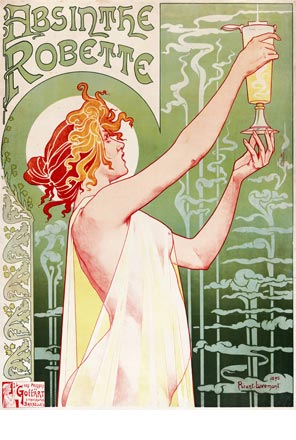
Absinthe Robette
Through the late 19th century and into the 20th, new posters advertising luxury goods were commissioned from influential Art Nouveau artists.
This Henri Privat-Livemont’s poster is typical of the style, with a Pre-Raphelite inspired figure enjoying the goods – in this case, Absinthe Robette.
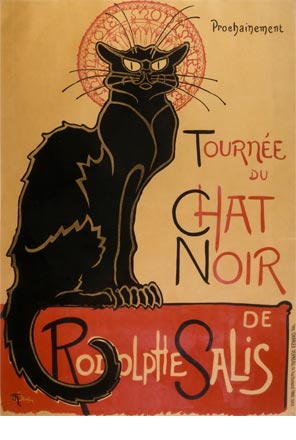
Le Chat Noir
Le Chat Noir was said to be the first modern cabaret, opening its doors in Paris in 1881.
This poster was created by Art Nouveau printmaker Théophile Steinlen in 1896 to promote an upcoming tour of the cabaret’s performers.
The club closed in 1897 after the death of its owner, Rodolphe Salis.

Priester
Soon the complexity of Art Nouveau poster design gave way to the simplicity of Sachplakat, or the “object poster”.
The originator of this stark style was an 18-year-old German cartoonist who designed under the name Lucian Bernhard. In 1906 he entered a poster competition with a design for Priester matches. His first draft is said to have featured a tabletop, ashtray, cigar and nymphs emerging from the tobacco smoke. Bernhard simplified until all that was left were two match sticks and the brand name.
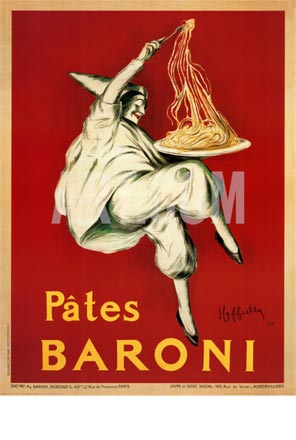
Pates Baroni
Leonetto Cappiello progressed this new fashion for posters with just a few strong elements. He turned the earlier style of artists like Jules Chéret into a bolder ad form with figures set against simple backgrounds.
While Chéret was called the father of the modern poster, Cappiello is often called the father of modern advertising. This 1921 pasta poster is one of his best known.
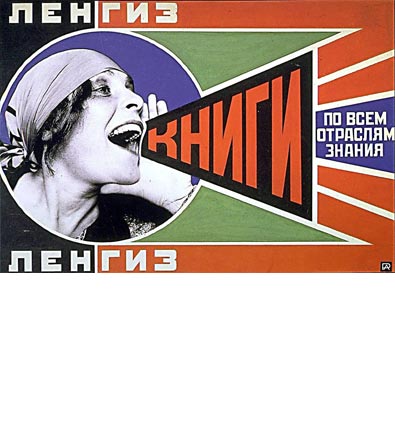
BOOKS!
Soviet posters have sparked many imitations across the design world. One of the most well-known from the 1920s was created for Soviet publisher Gsizdat by Alexander Rodchenko. It shows Lilya Brik, a prominent player in the Russian avant-garde scene, shouting “Books!”
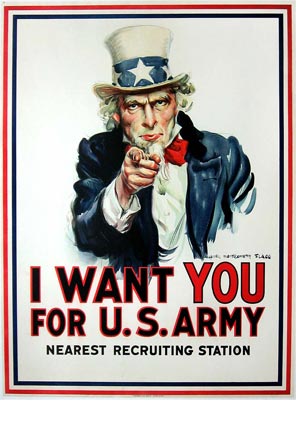
I Want YOU for US Army
J.M. Flagg’s famous 1917 poster was used to recruit soldiers to fight in World War I and World War II.
The artist used his own face as a model for Uncle Sam.
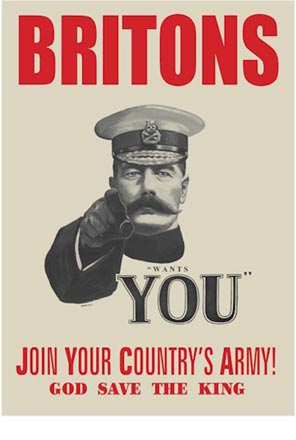
Lord Kitchener Wants You
This British poster, on which the American equivalent was based, features Lord Kitchener, the British Secretary of State for War, calling young men to arms in 1914.
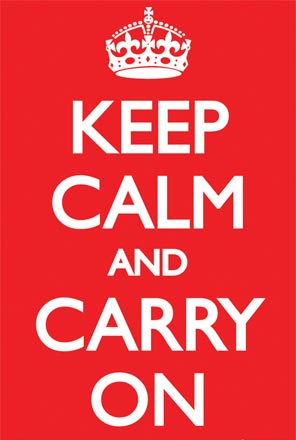
Keep Calm and Carry On
This poster was originally designed by the British Ministry of Information in 1939 to keep public morale up during World War II.
It was hardly used at the time, but 60 years later the print was rediscovered and its very British slogan (and countless variations) can be seen printed on tea towels, mugs and T-shirts today.
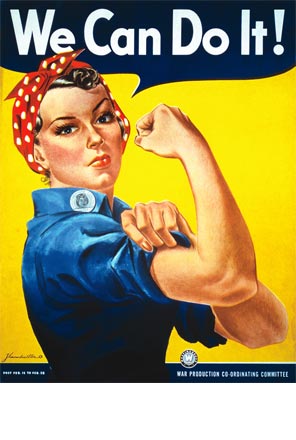
We Can Do It!
“We Can Do It!” started life as an American wartime propaganda poster in 1943, designed to boost workers’ morale.
In the 1980s it was rediscovered and its hero, who came to be known as “Rosie the Riveter”, found fame again as a symbol of feminism and political empowerment.
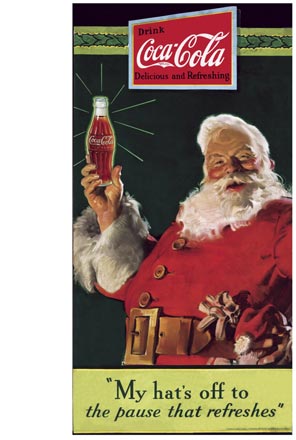
The Coca-Cola Santa Claus
Contrary to popular belief, Coca-Cola wasn’t the first to dress Santa in red – though the fact that the outfit was on-brand didn’t hurt.
The drinks company did however popularize the image of a cheerful, plump, white-bearded Santa that persists today.
This 1931 ad was illustrated by Haddon Sundblom.
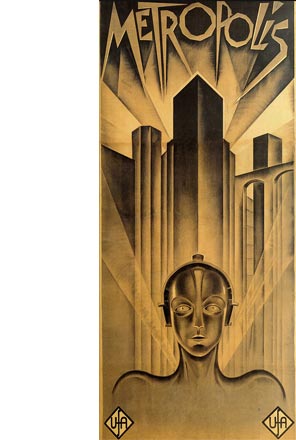
Metropolis
The poster for the 1927 sci-fi classic Metropolis was designed by German artist Heinz Schulz-Neudamm.
In 2005 it was sold at auction for $690,000 – the highest price ever paid for a poster.
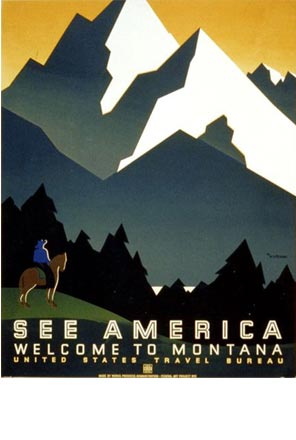
See America
In the Great Depression of the 1930s, U.S.President Franklin D. Roosevelt set up the Works Projects Administration to encourage economic growth.
Part of this project was creating work for artists like Dux Alexander, who designed a series of prints to attract tourists to American national parks.
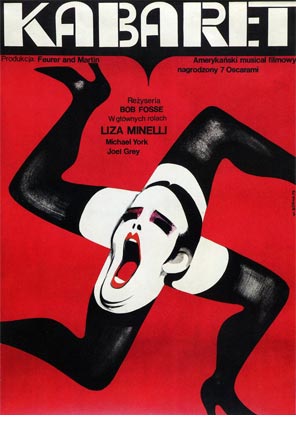
Kabaret
Designer Wiktor Górka fused sex and politics in a stockinged swastika to promote the 1972 film Cabaret.
Set in a 1930s German nightclub, the musical movie reveals Berlin’s bohemian underbelly and the growing shadow cast by the nascent Nazi party.
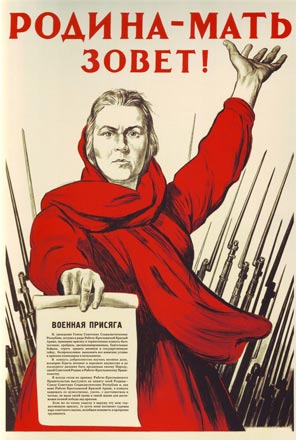
The Motherland calls!
One of the most iconic images in Soviet propaganda, The Motherland Calls features a woman in red staring into the viewers’ eyes as she leads a sea of bayonettes with her left hand held high. In her right hand she holds the oath of the Red Army.
The artist, Iralki Toidze, is said to have modeled the woman on his wife who, on the day of the German invasion, ran into his studio crying out news of the war. Toidze told her to freeze and immediately began sketching.
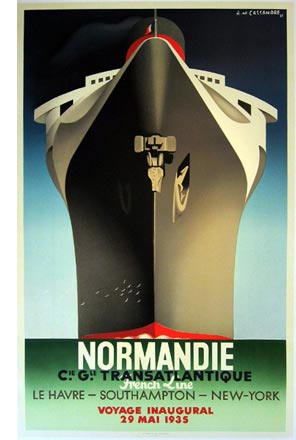
SS Normandie
The SS Normandie ocean liner, built in Saint-Nazaire in 1935, was the largest, fastest ship of her time.
Artist Adolphe Cassandre’s poster, which mirrors the Art Deco style of the Normandie’s interior, shows the ship’s massive bow head-on.
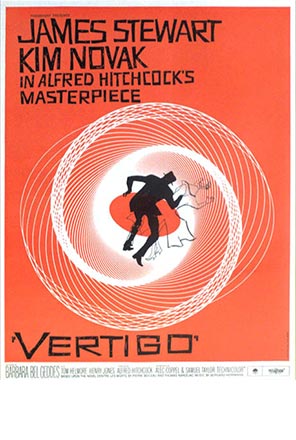
Vertigo
The poster for Alfred Hitchcock’s blockbuster was designed by Saul Bass, who was also famous for his film title-sequences. He was the first to create stylized sequences that integrated with the movie and set the audience’s mood
The poster’s vertiginous design shows two figures tumbling into the warped space Bass created using geometric shapes called hypotrochoid curves.
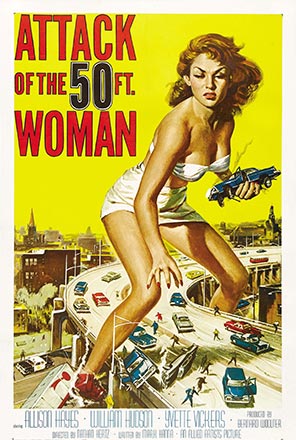
Attack of the 50 Foot Woman
Cinema-goers were no strangers to oversized men and giant apes, but 1958 saw the first female colossus hit the city in Attack of the 50 Foot Woman.
Painted by realist artist Reynold Brown, the movie poster shows the giant woman terrorizing citizens from what looks like a height much greater than 50 feet.
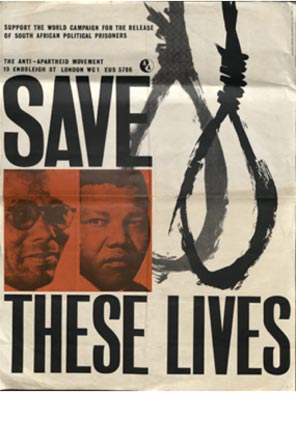
Save These Lives
In 1964, ten members of the African National Congress, including Walter Sisulu and Nelson Mandela, were charged with sabotage against the apartheid state.
The Anti-Apartheid Movement created this poster as part of a global campaign in response to fears that the defendants would be sentenced to death.
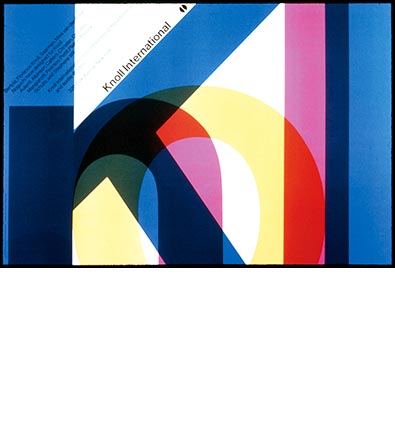
Knoll
Italian designer Massimo Vignelli experimented with color and depth-perception by layering the text in his 1970 poster for Knoll Textiles. The stacked letters overlap, creating new color mixes, but the brand name remains legible.
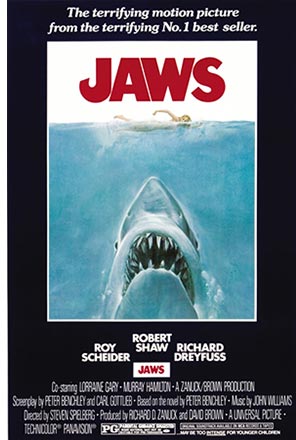
Jaws
Capturing our fear of the unknown in one image, Roger Kaste’s poster shows the moment before the great white attacks Chrissie Watkins.
The story’s first kill was also seen on the front cover of Peter Benchley's novel, on which the Spielberg blockbuster was based, but it was Kastel who made the shark a more life-like threat baring ragged rows of teeth.
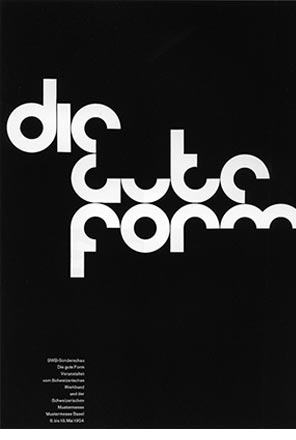
Die Gute Form
The dominant poster style that emerged after World War II came to be known as International Typographic Style. Its bold use of sans serif typefaces (especially Helvetica, the rising star of the font world) and monochrome photography was perfect for striking but clear communication in a global marketplace.
This poster by Armin Hofmann, one of the Swiss movement’s leading figures, is typical of the style with its grid-based design.

Swiss Typography
Another pioneer of typography, Wolfgang Weingart brought a sense of chaos back to poster art.
His offset printing experiments would break many of his predecessors’ rules and usher in the the new era of post-modern design as we know it today.
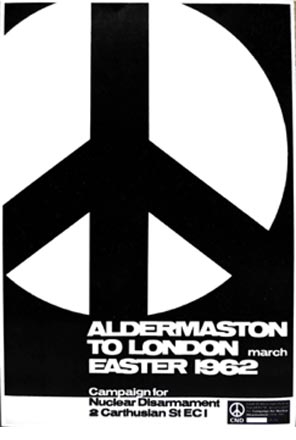
Peace
The universal symbol for peace was originally designed by Gerald Holtom for the British nuclear disarmament movement.
The artist created this poster for a march from Trafalgar Square, London, to the Atomic Weapons Research Establishment at Aldermaston.
The lines within the circle mirror the shapes made when the letters N and D, standing for “nuclear disarmament”, are spelled out in flag semaphore by a signalman.
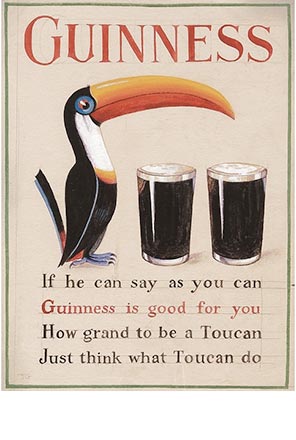
The Guinness Toucan
John Gilroy was the designer behind the memorable zoo animals in early Guinness ads. Most famous was the toucan, which came to represent the Guinness brand.
The copy accompanying the design was penned by English poet, playwright and crime writer Dorothy Sayers, whose time in the ad industry inspired her detective story, Murder Must Advertise.
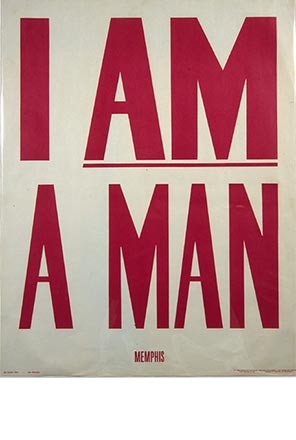
I Am A Man
On April 3, 1968, Memphis workers went on strike to fight for the right to unionize, following the death of two African-American sanitation workers.
Printed placards bearing the statement "I Am A Man” were held by members who gathered at the Mason Temple
It was to these 1,300 people that Martin Luther King Jr. delivered his “I’ve Been to the Mountaintop” speech. He was assassinated the next day.
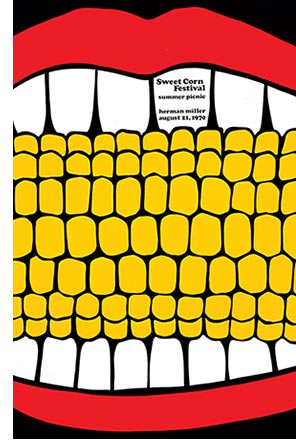
Sweet Corn Festival
Steve Frykholm’s designs began life as internal posters for the annual summer picnics at Herman Miller, where he began working in 1970.
His bold, foodie screen prints were so popular they became a highlight of the event for 20 years. Ultimately, the series found fame outside the company walls when they were exhibited at major institutions like New York’s Museum of Modern Art.
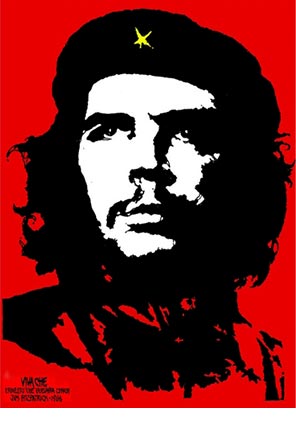
Che
The image of Ernesto “Che” Guevara has entered popular culture and come to stand for revolution everywhere.
This high-contrast design of the Argentinian icon was created by Irish artist Jim Fitzpatrick. If you look closely you’ll see the initial F that the artist hid on Che’s shoulder.
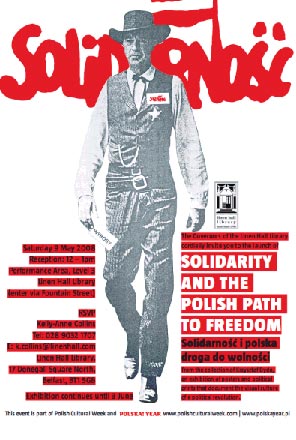
“High Noon 4 June”
Solidarity, the first non-government trade union in a Soviet-bloc country, was a driving force in Poland’s transition from one-party communism to modern democracy.
This lithographic by Tomasz Sarneck was used during the Polish election of 1989. It features Gary Cooper, star of American western “High Noon”, with a Solidarity badge on his chest and a ballot in his hand.
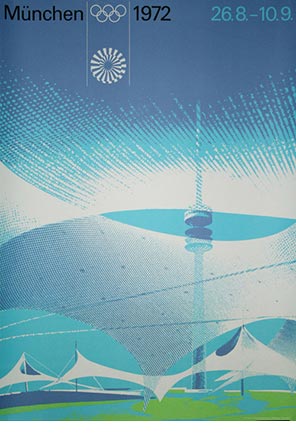
1972 Summer Olympics
As lead designer for the 1972 Summer Olympics in Munich, Otl Aicher created designs inspired by Alpine colors.
These colors were used thematically so that visitors could find their way around the Olympic village.
Aicher also designed pictographs for use around the site, and the influence of his round-ended stick figures can be seen on city signage today.

Labour Isn’t Working
This poster, created by advertising agency Saatchi & Saatchi for the Conservative Party, was plastered on British billboards in 1979. Some credit it with securing the Conservatives their win over the Labour Party.
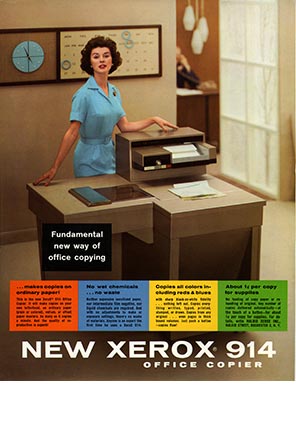
New way of office copying
The Xerox 914 was the first of its kind: an office copier that produced black & white copies on ordinary paper at the touch of a button.
Our 650-pound baby hit offices in 1960 and changed the way we work forever.
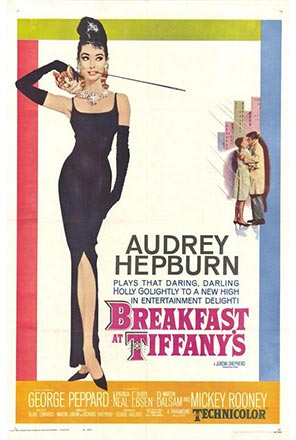
Breakfast at Tiffany’s
Breakfast at Tiffany’s, the Hollywood movie based on Truman Capote’s book, cast Audrey Hepburn in her most memorable role as Holly Golightly.
The poster for the 1961 movie was designed by American artist Robert McGinnis.
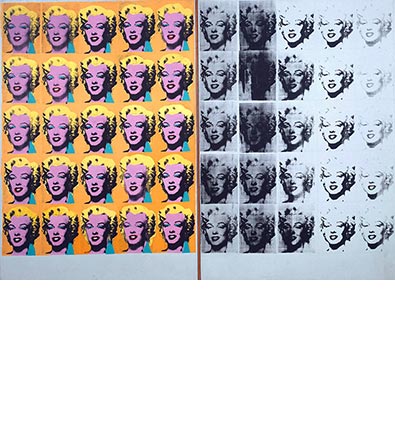
Marilyn Diptych
Andy Warhol popularized screen printing in the 1960s with his colorful pop art images of celebrities, Coca-Cola bottles and cans of Campbell’s Soup.
The Marilyn Diptych was created in 1962 after the death of the star and shows 50 images of her face, 25 in color, 25 in monochrome.
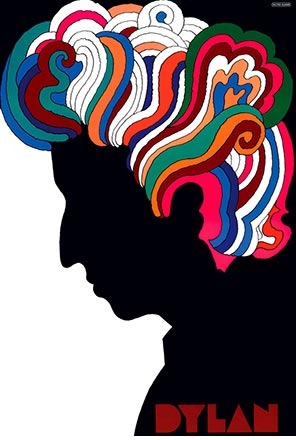
Dylan
Designed by Milton Glaser, this poster accompanied Bob Dylan’s Greatest Hits album in 1966.
The simple image was inspired by a 1957 Marcel Duchamp self-portrait, and Glaser added a touch of the psychedelic sixties with Dylan’s colorful mane.
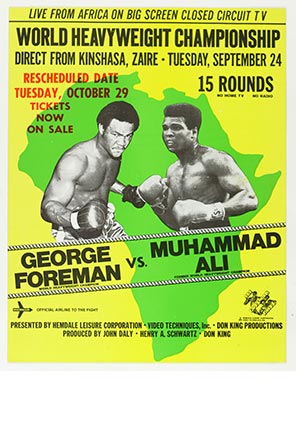
Rumble in the Jungle
The 1974 World Heavyweight Championship boxing match – also known as the Rumble in the Jungle – pitted undefeated world heavyweight champion George Foreman against challenger Mohammad Ali.
Held in Kinshasa, Zaire (now the Democratic Republic of the Congo), the Rumble ended in the eighth round with an Ali victory by knockout.
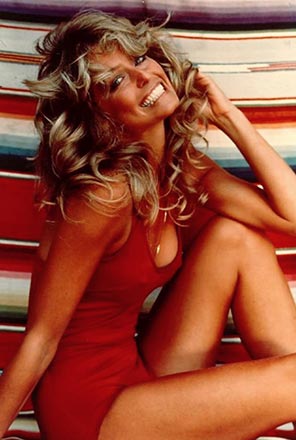
Farrah Fawcett
If you were a boy in the 70s, chances are Farrah Fawcett graced your bedroom wall.
The Charlie’s Angels star rose to fame on the back of this best-selling poster.
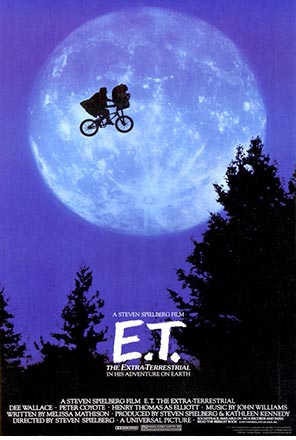
E.T.
This poster for Steven Spielberg’s 1982 classic captures the moment when Elliott and his extra terrestrial friend cross the moon on their escape to the forest.
It was called the most magical moment in cinema history by Empire magazine.

Pregnant Man
Another iconic political ad by Saatchi & Saatchi, this poster aimed to raise awareness for contraceptive services by turning the tables on men and asking a surprising question.
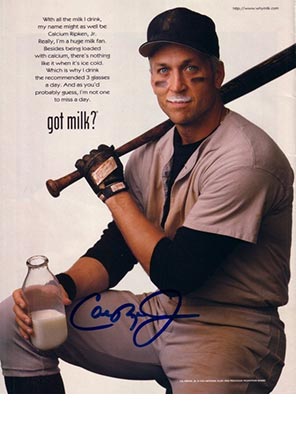
Got Milk?
Many famous faces have donned a white moustache under the “got milk?” banner since the posters first appeared in the nineties.
Created for the California Milk Processer Board, the milk-endorsing campaign has been credited with boosting dairy milk consumption in the California area and beyond. This 1996 image features baseball's Cal Ripken, Jr.
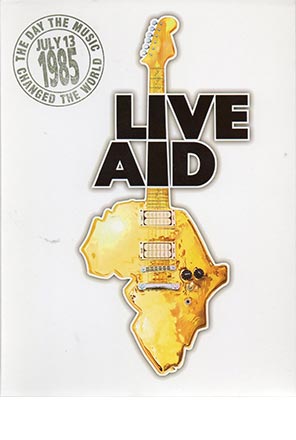
Live Aid
July 13, 1985 was celebrated as “the day that music changed the world.”
Organized to raise money for famine relief efforts in Ethiopia, simultaneous concerts took place in arenas in London and Pennsylvania, linked for live broadcast.
It’s estimated that to date the event has helped raise over $230 million for famine relief.
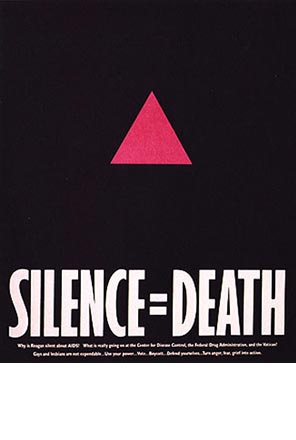
Silence=Death
In 1984, the Center for Disease Control reported 4,177 known cases of AIDS in America. Politicians, however, stayed silent on the epidemic.
In response, six gay activists formed the Silence=Death Project in New York. This poster appeared around the city with the message that open discussion was the only way to tackle the devastating issue.
The pink triangle recalls the shape used to mark out homosexuals in Nazi camps. In the poster it is inverted to symbolize the disavowal of victimhood.
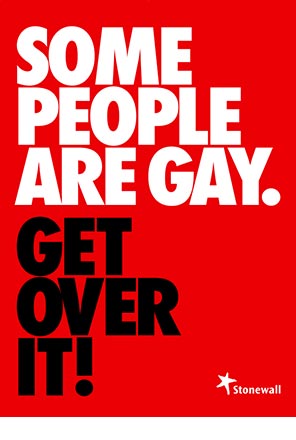
Some People Are Gay. Get Over It.
The black and white message in this poster was developed by Stonewall, the largest LGBT rights charity in Europe, with the help of 150 school teachers and pupils.
The poster served to raise awareness of Stonewall’s Education for All campaign, which tackles anti-gay bullying in schools.
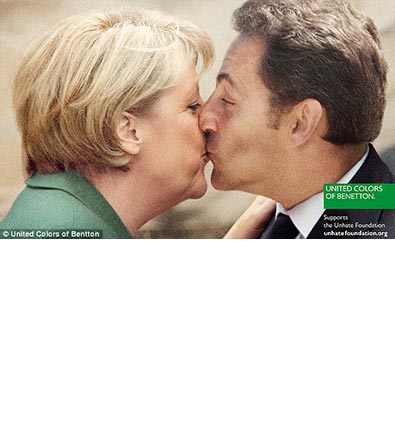
UNHATE
Fashion brand Benetton created a poster series to help launch UNHATE, a project designed to encourage world leaders and ordinary citizens alike to combat what it called the “culture of hatred”.
Thanks to some crafty editing, the provocative posters show powerful duos kissing, including German Chancellor Angela Merkel and French President Nicolas Sarkozy, U.S. President Barack Obama and Hugo Chavez of Venezuela, and the Pope and Ahmed Mohamed el-Tayeb, Imam of the Al-Azhar mosque in Cairo.
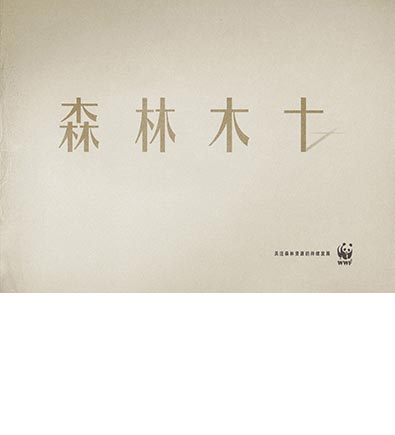
Forest / Woods / Tree / Death
This World Wide Fund for Nature poster used symbols and minimalist storytelling to raise awareness of the threat of deforestation. The three Chinese characters on the left can be translated as Forest, Woods, and Tree, each one reducing in turn, and the final symbol, stripped of its leaves, is not a character but a cross.
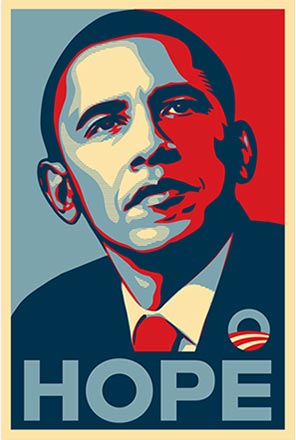
HOPE
Before it came to represent Obama’s 2008 presidential campaign, Shepard Fairey’s poster was designed in one day and sold on the street by the artist.
Its bold stencil design features a simple color palette of blues, beige and red. “Hope”, “Change”, “Progress” and other slogans were used at the foot of the image.

Only for children
Advertising agency Grey Spain worked with the ANAR Foundation, a Spanish child-advocacy organization, to create a poster that to most passers-by at street level read: “Sometimes child abuse is only visible to the child suffering it.”
Look from a child’s height, however, and you see bruises on the boy’s face and a different message: “If somebody hurts you, phone us and we’ll help you.”
With this smart use of lenticular printing, the foundation got their message safely to children who might need it.
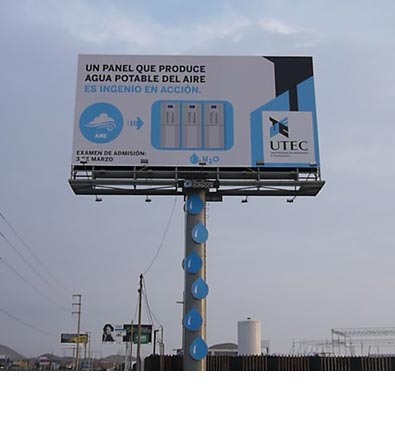
Making drinking water out of thin air
This billboard in Lima, Peru, is another great example of a poster that does as well as shows. Look inside and you’ll find five machines with built-in filtration systems that turn moisture in the air into drinking water.
Atmospheric humidity in Lima is around 98 percent but only half an inch of rain falls each year. This poster was created by UTEC, the country’s biggest university of engineering and technology, as a very practical response to the challenging conditions. It also served to attract more students to the university.
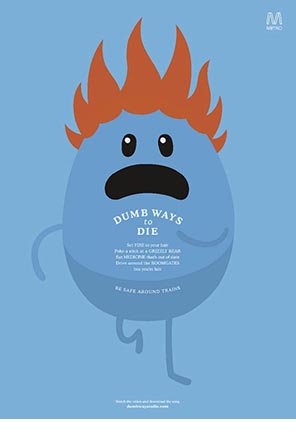
Dumb Ways to Die
The hapless characters in this rail safety campaign by Metro Trains in Melbourne, Australia, proved there are plenty of dumb ways to die – and helped to save lives along the way.
In 2012 the posters ran in parallel with a viral video and early results showed an amazing 20 percent reduction in accidents and near-misses on the Melbourne Metro.
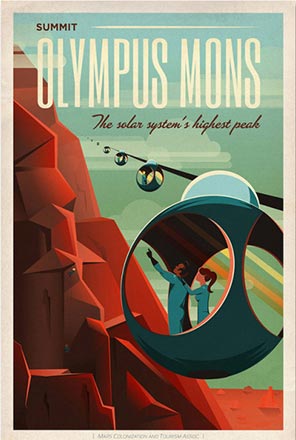
Visit Mars
Space Exploration Technologies Corporation (SpaceX) was founded by Elon Musk with the dream of one day taking humans to Mars.
The company created a series of posters looking ahead to a possible future of interstellar tourism when travellers can explore the Red Planet’s moons, its valleys and Olympus Mons which, as this poster tells us, is “the solar system’s highest peak.”
When can we book our tickets?
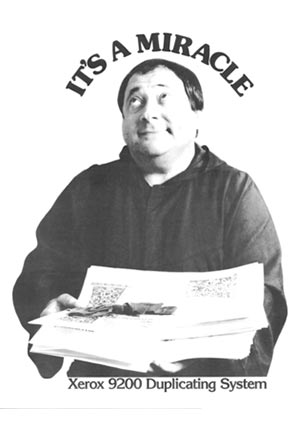
Bonus Poster
Brother Dominic
Okay, he may not have saved lives or won elections, but this monk changed our world at Xerox.
Hitting the screen in a Super Bowl ad in 1975, Brother Dominic went on to become the face of Xerox in the eighties. In posters like this one, he shared the good news that technology can do miraculous things for your working life.
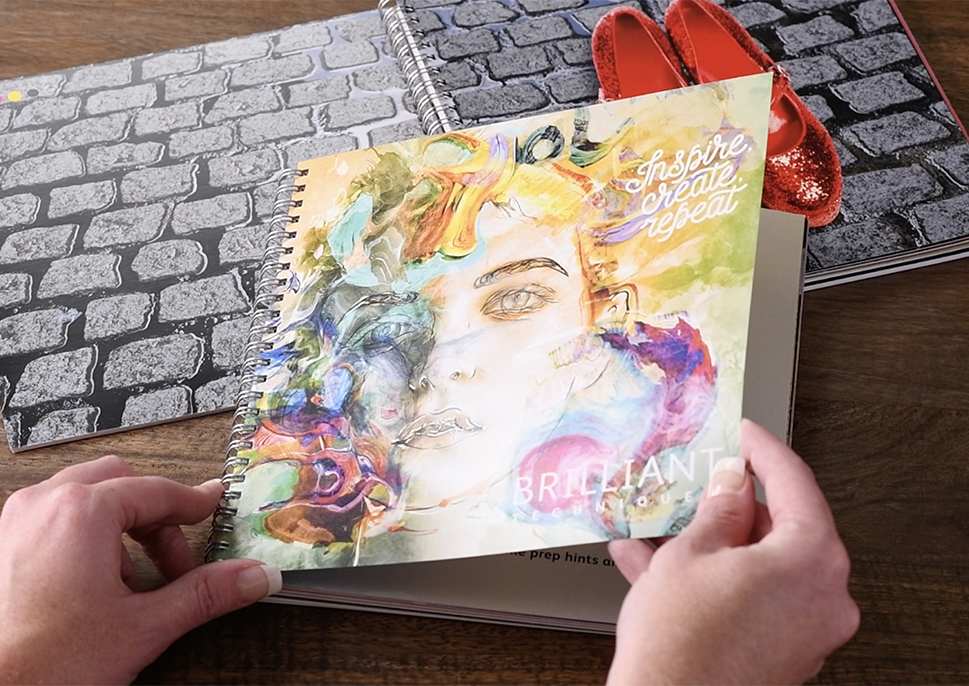
Free Your Creativity in Stunning New Ways
Make your designs stand out and be noticed with embellishments, metallic inks and more.
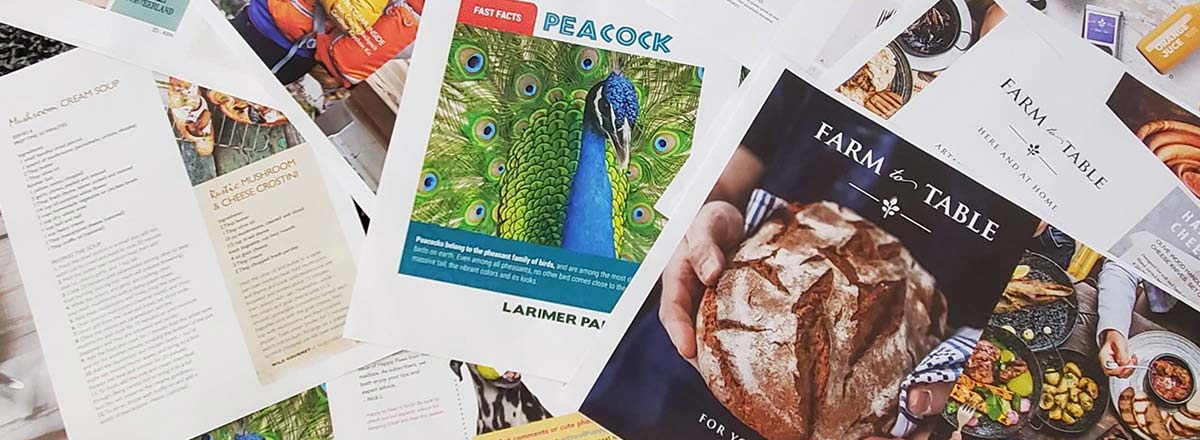
Inkjet is on Fire
High-volume, production inkjet printing is the fastest growing sector of the digital printing industry.
Find a Print Provider
Looking for a quality print partner, anywhere in the world? Find a Xerox Premier Partner in seconds.